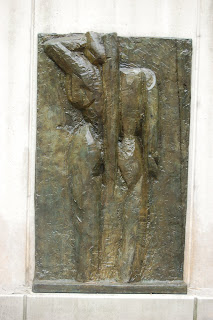 Large issues are easier to understand and synthesize when they are presented in humanized form. I spent my Thursday (which is my Monday in work days) evening and treated myself impromptuly to Stages Repertory Theatre's production of Eric Coble's "Southern Rapture." The last work I had seen of Eric's dealt with a family desperate need for their toddler to be in the right social circles that they end up committing murder to ensure his admission to an exclusive school. Hilarious. I expected the same out of "Southern Rapture" with the addition of one enticing attribute: nudity.
Large issues are easier to understand and synthesize when they are presented in humanized form. I spent my Thursday (which is my Monday in work days) evening and treated myself impromptuly to Stages Repertory Theatre's production of Eric Coble's "Southern Rapture." The last work I had seen of Eric's dealt with a family desperate need for their toddler to be in the right social circles that they end up committing murder to ensure his admission to an exclusive school. Hilarious. I expected the same out of "Southern Rapture" with the addition of one enticing attribute: nudity.Eric Coble traces the cold to boiling progress of a variety of huge conceptual issues. Censorship, public support of controversial art, the definition of art, the purpose of art, and the fine line between certain artistic content and moral decency. All in about 2 hours. By humanizing the issues, Coble truly makes us look through a cubist perspective: through all angles at the same time.
The story traces the cordial friendship of a small southern town mayor in Georgia and a theater director who decides to put on a play dealing with homosexual issues including a short nude scene where an aids infected young man gets his penis inspected for lesions. Pressure from church and society groups encourages the mayor to first suggest the play not be done, then using legal powers to prevent the performance ending with failed behind the scenes negotiations until the play went on. In essence, the struggle between the characters is a microcosm of the struggles between public funding organizations and progressive and "questionable" art movements.
Best quotes and general thoughts of the night, and excuse me if I get these wrong. They were stored in my head:
"Government was no part in deciding what is art and what it isn't. You artists pushed the envelope to cause controversy and public outcry, now we have to. We were happy not caring"
"You are spiritual and cultural pollution."
"Government either funds everything, of funds nothing."
"I'm not a lesbian. I am just hard to live with."
Art continues to expand its own vocabulary. Classical arts were easily identifiable. Visual art was on a frame. Sculpture was recognizable. Music was within parameters. Theater was narrative. Dance had rules. Today, lines blur. Performance art redefines genres. Technology expands artistic possibilities. Global connections encourages cultural collaborations. Our definition no longer has clean boundaries. We are forced to come up with parameters, however the task is impossible. So what does art do:
Expresses? Symbolizes? Decorates? Entertains? Contemplates? Challenges? Questions? Represents? Contemplates? Perplexes? Angers? Soothes? Connects? Relates? Narrates? Records? Explains?
The list goes on. I'd like to think that art makes me think. Thus this blog.
You have to go. For tickets, contact Stages Repertory Theatre.
Photos by Bruce Bennett
(L-R) Pamela Vogel as socialite Alissa Marchand, Jovan Jackson as Emmett, Jon
L. Egging as Mickey Stedman









